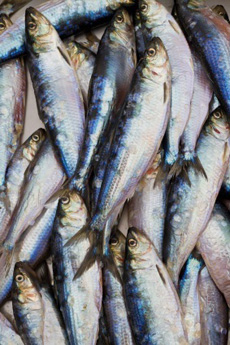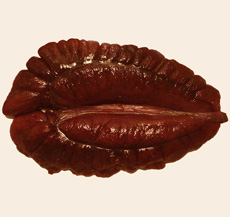TIP OF THE DAY: Shad Roe, An Ephemeral Delicacy
| Any Cole Porter fan knows about shad roe,* but how many have tasted it?
It’s shad roe season, trumpeting the eagerly anticipated delicacy that is available for about three weeks each year. The season is short because as the waters get warmer with the coming of spring, the shad swim upriver to spawn. The more they swim, the leaner they become; hence the need to catch them at the beginning of their sojurn. One champion of shad is Sandy Ingber, executive chef at the Grand Central Oyster Bar & Restaurant in New York City, who always lands the first shad of the season. He served the first shad and shad roe last Thursday, flown in from Georgia, and estimates there will be shad through April. “Shad is here, and I look forward to this delicacy every February at this time,” says Chef Ingber. “The inside ‘porcupine’ is delicious, and the roe is so delicate and wonderful that people come from all over the world to enjoy this treat.” Some fans reserve the roe from their fishmonger, so as not to be caught empty handed when the limited supplies arrive. |

Fresh-caught shad, beloved for its flesh and its roe. Photo by Jordan Rusev | IST. |
|
| He serves shad, roe, and a shad and shad roe combo with stuffed tomato and crispy bacon.(Gosh, don’t you wish you could be a global locavore, following seasonal foods all around the world?)The Lenape Native American tribe referred to shad as the “inside-out porcupine” because of its many bones. One reason it is such a delicacy is that few restaurants have the expertise it takes to filet and de-bone a shad. (Watch out, Top Chef contestants.) Another is the delicate roe.
*From “Let’s Do It (Let’s Fall In Love).” |
||

Shad roe. Photo by Docku | Wikimedia. |
What Is A Shad?
Shad, or river herring, belong to the same scientific family as conventional herring (Clupeidae). Several shad species can be found on both sides of the Atlantic Ocean and in the Mediterranean and Caspian Seas. Most species are found in freshwater only during spawning, while others are only found in landlocked freshwater. The American shad spends the majority of its life in salt water but returns to its river birthplace to breed in freshwater. It is a boney fish, typically three to five pounds. While its flesh is eaten, it is prized for its eggs, the shad roe. |
|
| Shad roe is not the prettiest food, either raw or cooked. In both instances, it visually resembles liver rather than fish. The flavor, however, is delicate—not at all fishy, an attribute some people ascribe to caviar and other roe. In fact, the flavor is so subtle that, like most delicate fish, it easily takes on the flavor of ingredients cooked with it—bacon, capers, mushrooms and onions, for example.
While shad roe is not that high in calories,† it is high in cholesterol: about 500 milligrams per modest three-ounce serving (similar to calf’s or beef liver). Then there’s the added cholesterol: bacon, often cooked with the shad, and the butter in which it is cooked. But it’s a once-a-year splurge. Call up the best seafood house in town to see if they have shad roe. Or, cash in those miles and head to the Grand Central Oyster Bar. In the words of Cole Porter, “Why ask if shad do it—Waiter bring me shad roe!” Or, call your local fishmonger, beg for a piece and try these two recipes from The New York Times. †One cup of shad roe, an average portion, has about 375 calories.
|
||


